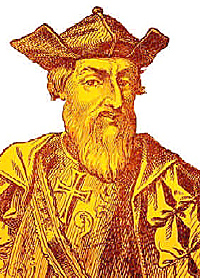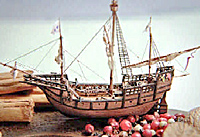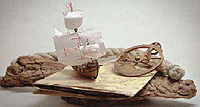 As the CH reader already knows, sometimes an interest in military or naval history leads to modeling and wargaming;
at times the process is the reverse, which is the case with my curiosity about Vasco da Gama and the
Portuguese age of discovery. To be sure, there was some latent fascination with the subject derived from my
encounter with the Swedish naval historian/illustrator Bjorn Landstrom’s marvelous pictures of swan-like high
castled and kaleidoscopic caravels, carracks, galleons and naos of the 15th- 17th centuries. In my opinion,
these vessels were so visually captivating, they immediately conjure up marvelous yarns about the maritime adventurers
themselves, as found in the pages of the entertaining nautical historian Samuel Eliot Morison.
As the CH reader already knows, sometimes an interest in military or naval history leads to modeling and wargaming;
at times the process is the reverse, which is the case with my curiosity about Vasco da Gama and the
Portuguese age of discovery. To be sure, there was some latent fascination with the subject derived from my
encounter with the Swedish naval historian/illustrator Bjorn Landstrom’s marvelous pictures of swan-like high
castled and kaleidoscopic caravels, carracks, galleons and naos of the 15th- 17th centuries. In my opinion,
these vessels were so visually captivating, they immediately conjure up marvelous yarns about the maritime adventurers
themselves, as found in the pages of the entertaining nautical historian Samuel Eliot Morison.
As an adolescent I was an avid modeler of nautical subjects. My predominant theme was the seagoing ships of the Age of Discovery. Revell’s little styrene facsimile of Drake’s Golden Hind remains one of my favorites.
It was only about four or five inches long, calling for some delicate brush strokes and careful decal application. But it was a gem. This diversion still takes up too much of my precious dollars, though my ancient fingers and eyesight no longer permit me to assemble and paint from kits. I have to go the more expensive route and purchase already built models.
A website, “Maritime Mystiques”, based in Switzerland, recently caught my attention. It offers the aficionado some highly detailed, artistically and historically accurate three-dimensional displays on the theme of Vasco da Gama’s voyages. By the way, I have no connection with anyone standing to profit by the sale of the artist’s handiwork. I discuss the models at the start to display what drew me to the subject.
 The centerpiece of each diorama is a meticulously rendered 1:400 scale model of one of da Gama’s flotilla of
three ships (four counting the supply vessel, not depicted). As the illustrations reveal, the model maker has
done his homework. Depending on which voyage, or segment of voyage, the artist is depicting, the ship
model is surrounded by some product or part of the natural habitat of the locale. In the case of the Cape of
Good Hope figure, there is a representation of a contemporary mariner’s chart and an astrolabe -- a navigational instrument of the period.
The centerpiece of each diorama is a meticulously rendered 1:400 scale model of one of da Gama’s flotilla of
three ships (four counting the supply vessel, not depicted). As the illustrations reveal, the model maker has
done his homework. Depending on which voyage, or segment of voyage, the artist is depicting, the ship
model is surrounded by some product or part of the natural habitat of the locale. In the case of the Cape of
Good Hope figure, there is a representation of a contemporary mariner’s chart and an astrolabe -- a navigational instrument of the period.
The following url will take you to the main page of the Vasco da Gama series.
- http://www.maritime-mystiques.com/coll-dagama-en.htm#preciousspicesofcalicuten
The other category that the artist hopes to model in the future is “classic yachts”, which from the illustrations would appear to be the large racing sloops of mid to late 20th century, rather than offshore or oceangoing luxury yachts or motor yachts. While this would appeal more specifically to the sailing ship enthusiast, I find the Vasco da Gama series more in tune with my historical predilection.
I decided to order a specially commissioned piece, showing the flagship, Sao Gabriel, with the astrolabe, chart, some indigenous driftwood and seashells and a section of hemp rigging, arranged in a nearly circular pattern so that a clear glass dome could be fitted to protect the work.
 Well, enough about my ship model fixation. While waiting for my creation to be fabricated, I did some
research on the subject in the library and on the Internet as well. I was surprised (but shouldn’t have been) to
find that the topic is shrouded in controversy. This is what I learned.
Well, enough about my ship model fixation. While waiting for my creation to be fabricated, I did some
research on the subject in the library and on the Internet as well. I was surprised (but shouldn’t have been) to
find that the topic is shrouded in controversy. This is what I learned.
Revisionist History And Historical Hindsighting
“You say ‘Exploitation’, I say ‘Exploration’; let’s call the whole thing off”
While Cole Porter wouldn’t be too thrilled at my twist on his classic lyric, the title epitomizes the all too familiar disputes roiling the academic world. “Eurocentric” narrative is judged to be incompatible with historical accuracy. The cultural relativism school disparages any review of the Age of Discovery that doesn’t reflect the imperialistic chauvinism of the explorers.
Christopher Columbus came in for his share of ex post facto criticism during the 500-year anniversary celebrations of his voyages ten years ago. Six years later it was Portugal’s turn in the dock, when that nation’s cultural heritage gurus were preparing to commemorate the Quincentennial observances of their national hero’s discovery of the sea route to the Indies.
The carping over da Gama’s character, intentions and achievements was most vigorous in Goa, which had the dubious distinction of being Asia’s first European colony. The Indian State of Goa was the focus of Portuguese power in India until 1961.
The Lisbon-based exhibition “EXPO '98” was attended by some 150 countries, which helped celebrate the theme “The Ocean and Oceanic Voyages”. Sympathetic to the Goa Freedom Fighters Association’s viewpoint that da Gama was more of a buccaneer than a pioneer, New Delhi's Ministry of Culture decided to pull out of the commemoration. Some Hindu clerical groups interpret Portuguese rule as a notorious chapter of religious aggression. On the other hand, the Leftists abhorred its colonial implications which, it could be argued, are still felt in some ways. The fact that the da Gama commemoration coincided with the 50th anniversary of India’s independence from British rule did not help matters. That coincidence became an embarrassment that shaped the Indian decision to send a low-level delegate and that for only the opening ceremony.
Equitable Compromise Or Capitulation?
The Portuguese conference organizer wasn’t insensitive about the situation and in a spirit of conciliation, suggested " … unfortunately, as you should agree, there is no nation and no culture that could invoke a past clean from oppression, greed or violence”. He went on to explain that the anniversary’s originators " … are certainly finding out much to our chagrin that our da Gama is not that of others. This is all quite unfortunate and is not really our stated intention."
In an effort to accommodate its critics, Portugal agreed to tone down the Eurocentric emphasis on Portugal's discovery of the sea route to India in favor of an approach that stressed the "encounter of two cultures."
Nevertheless, the objectors to the congress were not in a very compromising mood. As the commemorative year got underway, Indian and African immigrant groups in Portugal accused Portugal of trying to glorify a voyage that, in their perception, led to innumerable deaths and five centuries of European colonial rule
Typical of the immigrant opinion, is the following rather lopsided notion: "Da Gama set fire to ships, tortured and killed countless numbers of women and children. If we have to salute this figure, then we might as well celebrate every other act of aggression committed by foreign countries against India."
Then there’s the customary New Left ideologues’ version of the Age of Discovery, condemning what they term “The Ideology of Racism”:
- For the conquest to systematically continue after the invasion, it was necessary for European-whites
to create a new social order with them at the top. For whites to be on top, it became necessary
to (1) objectify Indians and eliminate all cultural distinctions between the indigenous
populations; (2) portray the indigenous populations and their offspring as inherently inferior;
and (3) portray the offspring of European and Indian unions as inferior.
After the indigenous populations were decimated by murder and disease, the European colonists had to find replacement slaves to continue their exploitation of the Americas.
In 1498, the European explorer Vasco Da Gama sailed around the Cape of Good Hope in Africa and "discovered" the solution to the need for additional laborers in the Americas: African slaves.
This rather vapid piece of sloganeering combines an antiquated Marxist harangue with trendy cultural relativist lament. Nobody would have been more surprised than the intrepid explorer to learn that his real motivation was to procure human chattel for New World plantations that wouldn’t get going for at least another couple of centuries. In any event the dark years of Portuguese slave dealing didn’t occur until the beginning of the 19th century. And the writer neglects to mention that the Arabs, and local African chieftains, had been dealing in slaves for centuries before the advent of the Portuguese.
This is a blind spot that afflicts most “anti-colonialist” writers of the left.
It would be unfair to suggest that all of da Gama’s detractors are as shallow or sanctimonious. Vasco da Gama’s modern critics make a valid point that is worth consideration.
Anti-da Gama protests, a commonplace in India, are a strange phenomenon in Portugal, which prides itself as being a country of discoverers, where students still recite 15th-century poems (The Lusiads) recounting the legends of Portuguese exploration. Portugal has long regarded da Gama as a symbol of a golden era when bold seamanship transfigured the southwest European nation, which is only about the size of Maine, into a world power.
Portugal’s homegrown leftists opposed the celebrations on the grounds that they would reawaken memories of Portugal's more recent authoritarian past under longtime dictator Antonio de Oliveira Salazar, who ruled from 1932 to 1968. As the radicals reminded their fellow citizens Salazar had employed the symbol of da Gama to buttress costly and highly unpopular efforts to prolong a bitter, unwinnable colonial war in Africa. Not all third world spokesmen were so adverse.
One Indian intellectual acknowledged that "You might not have wanted him for your next-door neighbor, but I have my doubts about whether you would have liked to have the reigning Indian rulers of the time as your neighbors either”.
Fundamentally, da Gama's reputation has also been the victim of the way history itself is being reexamined. This broader perspective accommodates the views of non- European societies.
Sanjay Subrahmanyam, who has recently completed a revisionist biography of da Gama, acknowledges that " …there is a tendency these days to attack historical figures in simplistic ways, but it is problematic to judge him by 20th-century standards, to draw a straight line between da Gama and the misfortunes that followed his arrival. He had the attitude of many people of his time."
Historians generally concur that, much like Columbus, da Gama was a complicated character. He was deeply religious and hot-tempered, brutal to the Indians and to the Portuguese under his command. Even though greed and personal aggrandizement may have motivated him, he also contributed positive achievements, among them the establishment of new forms of farming and maritime trade. Notwithstanding, it is indisputable that da Gama was merciless in his treatment of native populations when their behavior wasn’t docile or compliant enough to conform to the European stereotype of benign primitives. On a lighter note, he had abominable taste when it came to selecting appropriate gifts. The latter point will become more evident later in this article.
Reaction
All of this breast-beating unburdening of guilt has aroused a predictable backlash. Some of it, written by fanatic white supremacists was predictably racist. Typical is this extract from March Of The Titans - A History Of The White Race (Chapter Forty Seven - The Portuguese and Dutch):
- The Portuguese explorer, Vasco da Gama, was the first White to reach India by sea, throwing
anchor off the harbor of Calicut in May 1498. De Gama established friendly relations with the
local Indian ruler, and secured a monopoly of Indian trade for Portugal which lasted for a century.
However, Portugal lost its position of pre-eminence in Europe after it absorbed hundreds
of thousands of Black slaves, and by the early 17th century, the Dutch had replaced Portugal
as the main trading nation with India, through the Dutch East India Company.
Note that the author would like the reader to swallow his contention that the importation of black slaves, who mixed with the largely Caucasian populace of Portugal, had corrupted the race so that the country lost it’s supremacy in international affairs. The writer doesn’t condemn slavery on the grounds that it’s morally repugnant; merely because it allegedly contaminated the Portuguese gene pool.
The ripostes of Portuguese nationalists were not quite as bigoted. Vasco Antonio Velez, director of the Foundation for the Discoveries, is one of the most vocal members of the anti-PC – or rather Portuguese Pride – persuasion. In an essay in the O Publico newspaper, Mr. Velez claimed Portugal doesn't need to make any apologies for da Gama. "Da Gama was a hero, he changed the fate of the world forever, and he changed it for the better. "It's a shame that he's being raked over the coals, forced to take a bad rap for something he may or may not have done. Let's get on with it," Velez wrote.
And so, taking Professor Velez’s advice, let’s get on with describing just what da Gama accomplished – warts and all. One has to begin with the invaluable legacy of forerunners who provided da Gama with the knowledge and expertise to ensure the success of his perilous mission.
More Will the Real Vasco de Gama Please Stand Up
- Introduction
Scientific Foundations: Prince Henry The Navigator And His Disciples
Underway – Headed for the World’s Extremities
Calcutta at Last
Map: Vasco de Gama's Route (slow: 129K)
Back to Cry Havoc #39 Table of Contents
Back to Cry Havoc List of Issues
Back to MagWeb Master Magazine List
© Copyright 2002 by David W. Tschanz.
This article appears in MagWeb (Magazine Web) on the Internet World Wide Web. Other military history articles and gaming articles are available at http://www.magweb.com